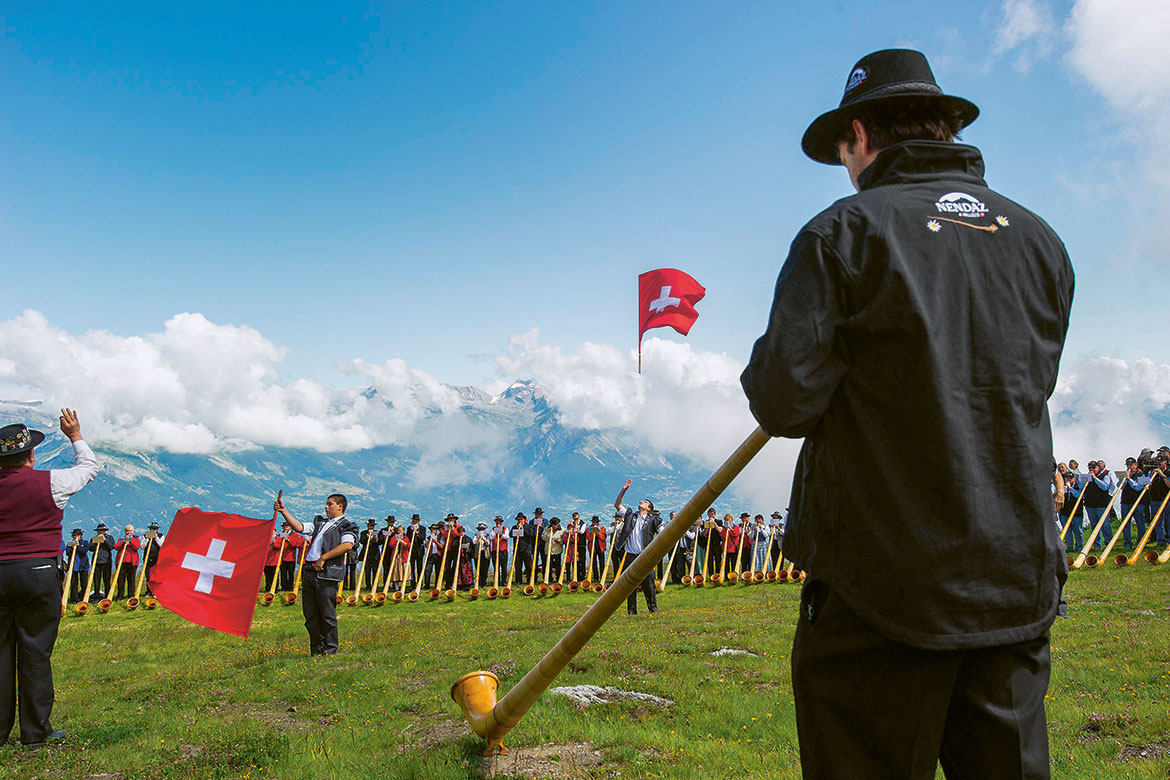Yodelling and alphorns: a mythical kinship
Inseparable in today’s boom in Alpine music, yodelling and alphorns have never been studied together. A team from the Lucerne School of Music reveals a complex relationship between the two practices.

The plaintive sounds of the alphorn, plus the Swiss mountains – both are identity-forming. Together with yodelling, they form a triune source of nostalgia. | Image: Keystone/Jean-Christophe Bott
Desertions, suicides, fatal concussions: this is what was said to happen to Swiss mercenaries seized by homesickness when they heard the melody of a Ranz des Vaches – a genre of shepherd’s song practised in the Swiss Alps. These incidents, whether real or imaginary, were reported in the scholarly literature of the 18th and 19th centuries, representing Switzerland as a hotbed of nostalgia and giving the music worldwide fame. In the Romantic imagination, these melodies with links to cattle breeding became emblematic of an identity rooted in Alpine life. Whether sung or played, they ended up being perceived as the matrix of two practices that would extend these pastoral traditions into the 20th and 21st centuries: yodelling and the alphorn ... But is this really what happened? “That would be too simple. The reality is more complex”, says Raymond Ammann, a professor at the Lucerne School of Music, who has been leading the research project entitled: ‘The musical relationship between the alphorn and yodelling – fact or ideology?’. The results have just been published in the book Alpenstimmung.
“There have never been as many people performing these practices as there are today”, says Ammann, who estimates that there are more than 3,000 active alphorn blowers. The Federal Association of Yodellers, founded in 1910, currently has 20,000 members. This is an impressive number if you consider that “the alphorn and yodelling almost disappeared in the 19th century”. The current success is the starting point for Ammann’s study, he says. “Instrumentalists often ask one another: should the alphorn should be played like any other wind instrument, or to imitate yodelling?”.
First joint survey
The ethnomusicologist Charlotte Vignau was the author of the 2013 transnational study ‘Modernity, Complex Societies, and the Alphorn’, and is now an external consultant for Ammann’s research. In her view, “the possible relationship between yodelling and the alphorn had never been examined. Earlier studies were certainly based on the same historical sources but dealt with one or the other of these two practices”. In order to carry out the investigation, documentary verification was conducted further to the examination of written sources and sound recordings, and practical experiments were carried out on the historical horns found in Swiss museums.
There was a need to verify whether these old horns could produce the ‘eleventh harmonic’, a characteristic note found both in yodelling and in the melodies of today’s horns. “It was thought that instruments of the 17th and 18th centuries were too short to play this note, which would have ruled out the hypothesis of an ancient connection with yodelling. In reality, alpine horns were probably shortened in iconography because their length was problematic for picture composition”, says Ammann.
Varying influences
The results therefore point to complexity. “Yes, there have been influences between the two practices, but they have not been constant and there is no evidence that they were foundational. Those we have identified are due in particular to composers who, in the 19th and 20th centuries, copied the scale of the alphorn to write yodelling melodies”, Ammann says. Having never been isolated, traditional practices and individual initiatives have taken their place in the interaction of socio-cultural forces.
Among these influencing factors is the success of ‘Tyrolean singing’ at the end of the 19th century and the reaction of Swiss yodelling to this foreign influence; the adaptation of the Ranz des Vaches to the scale of the piano to celebrate alpine nature in bourgeois interiors; and the tendency to monetise this music with tourists. Against the background of the current yodelling and alphorn boom, Ammann’s study will undoubtedly enter the fray as yet another influence, which he hopes will be liberating: “Everyone should make their own choices about how to play and sing”.



